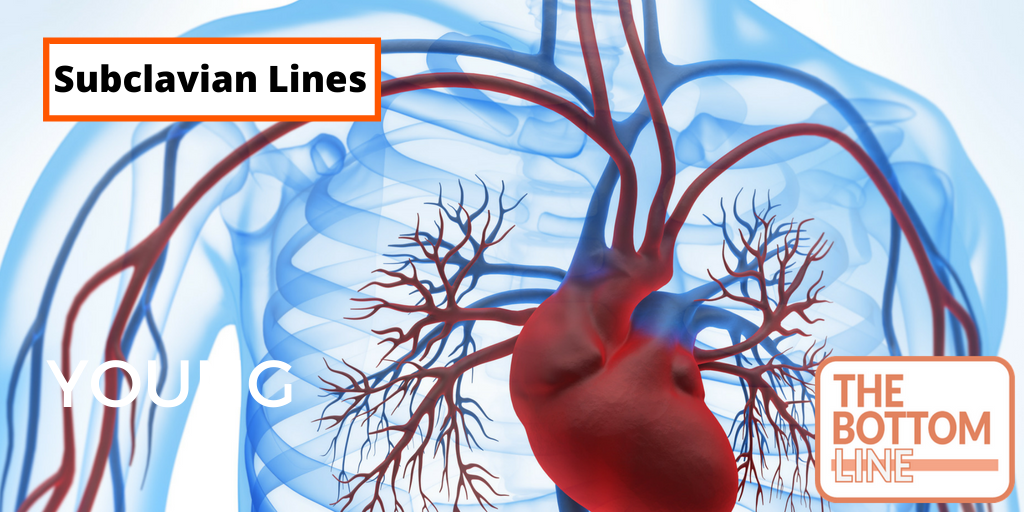SUBCLAVIAN LINES

Supraclavicular versus infraclavicular approach for ultrasound-guided right subclavian venous catheterisation: a randomised controlled non-inferiority trial
Kim. Anaesthesia 2022,77(1)59-65; doi.org/10.1111/anae.15525
Clinical Question
- In patients undergoing elective neurosurgery, is a supraclavicular in-plane ultrasound guided approach, compared with an infra-clavicular out-of-plane ultrasound guided approach, non-inferior for catheterisation-related complication?
Background
- The internal jugular, femoral and subclavian veins are commonly used for central venous lines
- The use of subclavian lines is associated with a lower risk of infection but a higher risk of pneumothoraces
- Subclavian lines can be placed either supra or infra-clavicular. Previous single operator RCTs (1, 2) have demonstrated that for a single operator ,ultrasound guided supraclavicular approach was quicker, with similar success rates and fewer complications, compared with an infraclavicular approach
- When an infra-clavicular approach is used the use of the short axis out-of-plane ultrasound has been reported to have significant advantages over the use of long axis in-place ultrasound
Design
- Randomised controlled trial
- Non-inferiority trial
- Computer generated random allocation sequence, 1:1 ratio
- Use of sealed opaque envelopes to maintain allocation concealment
- Sample size calculation: 416 patients. With a false positive rate set at 5%, false negative rate set at 20%, and non-inferiority margin set at 5.9%, 416 patients required assuming a drop-out rate of 5%
Setting
- Single centre, Seoul National University Hospital
- September 2018 – May 2020
Population
- Inclusion:
- Age 20-79
- Required central venous catheterisation
- Undergoing elective general anaesthetic for neurosurgery
- Exclusion:
- Infection or medical device at the puncture site
- Right subclavian venous thrombosis
- Haemostatic disorders or receiving anticoagulant
- Previous history of surgery that might distort the anatomy of the right subclavian vein
- 416 patients randomised. 8 patients excluded as not appropriately allocated, 4 withdrew consent, and 3 did not meet inclusion criteria, leaving 401 patients included in analysis
- Comparing baseline characteristics of intervention vs. control group
- Male: 45% vs 49%
- Age: 53 vs 51 years
- BMI: 24 vs 25
- ASA 1/2: 79% vs 80%
- ASA 3: 17% vs 18%
- ASA 4: 4% vs 2%
Intervention
- Supra-clavicular approach
- Long-axis in-plane ultrasound
Control
- Infra-clavicular approach
- short-axis out-of-plane ultrasound
Management common to both groups
- All other peri-operative management was the same
- Central line inserted after induction of general anaesthesia. Bed in flat position, with pillow removed and head, neck and arms in a neutral position
- VscanTM portable ultrasound machine
- One of four anaesthetists who all had at least 10 successful cannulations with both approaches
- Mechanical ventilation stopped prior to venous puncture, and re-started after successful catheterisation
Outcome
- Primary outcome: proportion of patients with catheterisation-related complications, including catheter misplacement and mechanical complications (arterial puncture, haematoma formation, pneumothorax and haemothorax)
- 3% in supra-clavicular vs 13.4% in infra-clavicular group
- Mean difference -10.4% (95% CI -15.7 to -5.1%), OR 0.20 (95% CI 0.8-0.49), p<0.001
- 3% in supra-clavicular vs 13.4% in infra-clavicular group
- Secondary outcomes:
- Comparing intervention vs. control group
- No significant difference in
- Overall success
- 99.5% vs 99.5%
- Success at 1st attempt for catheterisation
- 87% vs 88%
- Time required for catheterisation
- 79 vs 78 seconds
- Incidence of mechanical complications
- 2% vs 3%
- Arterial puncture
- 2% vs 1.5%
- Pneumothorax
- 0% vs 1%
- Rescue ventilation
- 14.5% vs 12.4%
- Overall success
- Significantly less in supra-clavicular group
- Catheterisation related complication
- 3% vs 13.4%
- Mean difference -10.4 (95% CI -15.7 to -5.1%), OR 0.2 (0.08-0.49), p<0.001
- Catheter misplacements
- 1% vs 10.4%
- Mean difference -9.4 (95% CI -13.9 to -5), OR 0.09 (0.02-0.37), p<0.001
- Catheter misplacement into ipsilateral internal jugular vein 0.5% vs 8%
- Mean difference -7.5 (95% CI -11.4 to -3.6%), OR 0.06 (0.01-0.44), p<0.001
- Time required for venous puncture
- 9 vs 13 seconds
- Catheterisation related complication
- No significant difference in
Authors’ Conclusions
- The supraclavicular approach seems to be a better approach for ultrasound-guided right subclavian venous catheterisation
Strengths
- Randomised controlled trial
- Multi-operator, all operators were experienced with both techniques
- Allocation concealment maintained
Weaknesses
- The supraclavicular approach used an inplane ultrasound where as the infaclavicular approach used out-of plane ultrasound. Although i understand the reasons for this, this may be a confounding variable
- This was a non-inferiority study and and was not designed to address superiority
- Single centre study in South Korea
- Only included patients who were mechanically ventilated and having elective neurosurgery. Results may not be generalisable to other settings
- Blinding of those inserting lines not possible
- 3.6% of patients randomised not included in analysis
The Bottom Line
- In elective patients undergoing subclavian central line insertion, the use of a supra-clavicular approach with in-plane ultrasound was non-inferior to an infra-clavicular approach with out-of-plane ultrasound.
- The success rates were similar for both approaches where as the rate of catheter related complications was significantly less with the supra-clavicular approach. This was predominately due to a reduction in catheter misplacement
External Links
- [article] Supraclavicular versus infraclavicular approach for ultrasound-guided right subclavian venous catheterisation: a randomised controlled non-inferiority trial
- [further watching] How To: Supraclavicular Approach to Subclavian Vein Cannulation – SonoSite Ultrasound
Metadata
Summary author: @davidslessor
Summary date: 14th Jan 2022
Peer-review editor: @avkwong
Picture by: [author/site]



